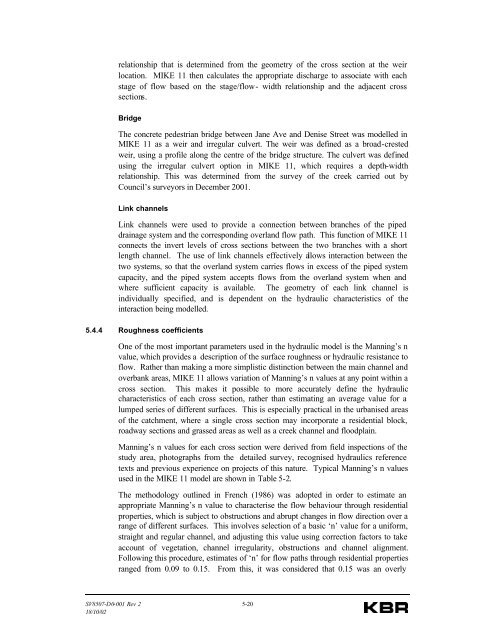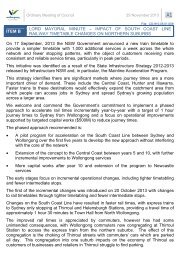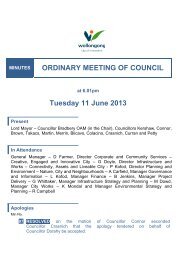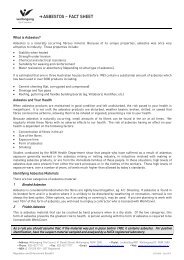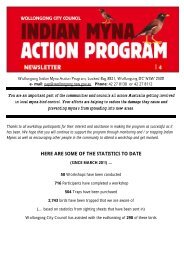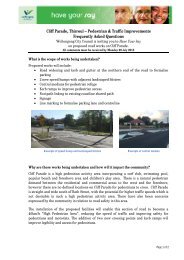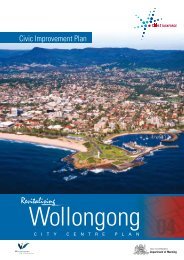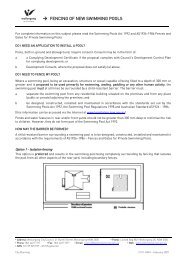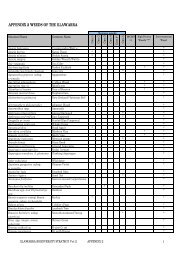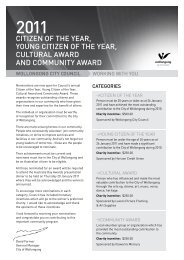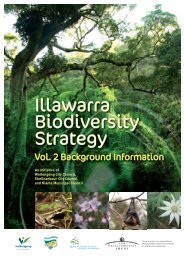Minnegang Creek Flood Study Report - Wollongong City Council
Minnegang Creek Flood Study Report - Wollongong City Council
Minnegang Creek Flood Study Report - Wollongong City Council
- No tags were found...
Create successful ePaper yourself
Turn your PDF publications into a flip-book with our unique Google optimized e-Paper software.
elationship that is determined from the geometry of the cross section at the weirlocation. MIKE 11 then calculates the appropriate discharge to associate with eachstage of flow based on the stage/flow- width relationship and the adjacent crosssections.BridgeThe concrete pedestrian bridge between Jane Ave and Denise Street was modelled inMIKE 11 as a weir and irregular culvert. The weir was defined as a broad-crestedweir, using a profile along the centre of the bridge structure. The culvert was definedusing the irregular culvert option in MIKE 11, which requires a depth-widthrelationship. This was determined from the survey of the creek carried out by<strong>Council</strong>’s surveyors in December 2001.Link channelsLink channels were used to provide a connection between branches of the pipeddrainage system and the corresponding overland flow path. This function of MIKE 11connects the invert levels of cross sections between the two branches with a shortlength channel. The use of link channels effectively allows interaction between thetwo systems, so that the overland system carries flows in excess of the piped systemcapacity, and the piped system accepts flows from the overland system when andwhere sufficient capacity is available. The geometry of each link channel isindividually specified, and is dependent on the hydraulic characteristics of theinteraction being modelled.5.4.4 Roughness coefficientsOne of the most important parameters used in the hydraulic model is the Manning’s nvalue, which provides a description of the surface roughness or hydraulic resistance toflow. Rather than making a more simplistic distinction between the main channel andoverbank areas, MIKE 11 allows variation of Manning’s n values at any point within across section. This makes it possible to more accurately define the hydrauliccharacteristics of each cross section, rather than estimating an average value for alumped series of different surfaces. This is especially practical in the urbanised areasof the catchment, where a single cross section may incorporate a residential block,roadway sections and grassed areas as well as a creek channel and floodplain.Manning’s n values for each cross section were derived from field inspections of thestudy area, photographs from the detailed survey, recognised hydraulics referencetexts and previous experience on projects of this nature. Typical Manning’s n valuesused in the MIKE 11 model are shown in Table 5-2.The methodology outlined in French (1986) was adopted in order to estimate anappropriate Manning’s n value to characterise the flow behaviour through residentialproperties, which is subject to obstructions and abrupt changes in flow direction over arange of different surfaces. This involves selection of a basic ‘n’ value for a uniform,straight and regular channel, and adjusting this value using correction factors to takeaccount of vegetation, channel irregularity, obstructions and channel alignment.Following this procedure, estimates of ‘n’ for flow paths through residential propertiesranged from 0.09 to 0.15. From this, it was considered that 0.15 was an overlySV8507-D0-001 Rev 2 5-2018/10/02


